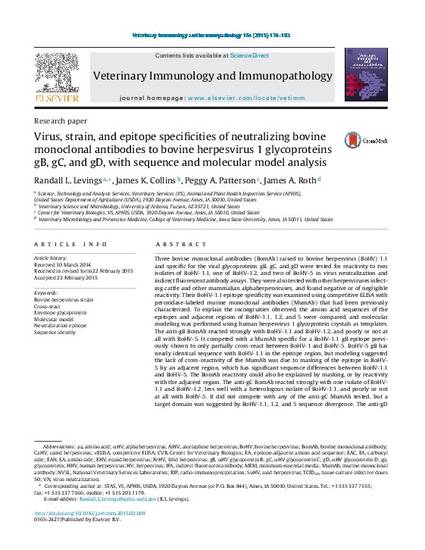
Article
Virus, Strain, and Epitope Specificities of Neutralizing Bovine Monoclonal Antibodies to Bovine Herpesvirus 1 Glycoproteins gB, gC, and gD, with Sequence and Molecular Model Analysis
Veterinary Immunology and Immunopathology
Document Type
Article
Disciplines
Publication Date
4-1-2015
DOI
10.1016/j.vetimm.2015.02.009
Abstract
Three bovine monoclonal antibodies (BomAb) raised to bovine herpesvirus (BoHV) 1.1 and specific for the viral glycoproteins gB, gC, and gD were tested for reactivity to two isolates of BoHV-1.1, one of BoHV-1.2, and two of BoHV-5 in virus neutralization and indirect fluorescent antibody assays. They were also tested with other herpesviruses infecting cattle and other mammalian alphaherpesviruses, and found negative or of negligible reactivity. Their BoHV-1.1 epitope specificity was examined using competitive ELISA with peroxidase-labeled murine monoclonal antibodies (MumAb) that had been previously characterized. To explain the incongruities observed, the amino acid sequences of the epitopes and adjacent regions of BoHV-1.1, 1.2, and 5 were compared, and molecular modeling was performed using human herpesvirus 1 glycoprotein crystals as templates. The anti-gB BomAb reacted strongly with BoHV-1.1 and BoHV-1.2, and poorly or not at all with BoHV-5. It competed with a MumAb specific for a BoHV-1.1 gB epitope previously shown to only partially cross-react between BoHV-1 and BoHV-5. BoHV-5 gB has nearly identical sequence with BoHV-1.1 in the epitope region, but modeling suggested the lack of cross-reactivity of the MumAb was due to masking of the epitope in BoHV-5 by an adjacent region, which has significant sequence differences between BoHV-1.1 and BoHV-5. The BomAb reactivity could also be explained by masking, or by reactivity with the adjacent region. The anti-gC BomAb reacted strongly with one isolate of BoHV-1.1 and BoHV-1.2, less well with a heterologous isolate of BoHV-1.1, and poorly or not at all with BoHV-5. It did not compete with any of the anti-gC MumAb tested, but a target domain was suggested by BoHV-1.1, 1.2, and 5 sequence divergence. The anti-gD BomAb reacted strongly with all BoHV-1.1, 1.2, and 5 isolates tested. However, it competed with two MumAb previously shown to not cross-react between BoHV-1.1 and BoHV-5. Sequence analysis and modeling suggested the cross-reactivity of the anti-gD BomAb was due to it reacting with an epitope-adjacent region or regions conserved between BoHV-1.1 and BoHV-5, but not with other alphaherpesviruses. The results suggest the usefulness of combining in vitro biological data with sequence or structure modeling data to investigate important epitopes involved in immunity to infectious agents.
Rights
Works produced by employees of the U.S. Government as part of their official duties are not copyrighted within the U.S. The content of this document is not copyrighted.
Language
en
File Format
application/pdf
Citation Information
Randall L. Levings, James K. Collins, Peggy A. Patterson and James A. Roth. "Virus, Strain, and Epitope Specificities of Neutralizing Bovine Monoclonal Antibodies to Bovine Herpesvirus 1 Glycoproteins gB, gC, and gD, with Sequence and Molecular Model Analysis" Veterinary Immunology and Immunopathology Vol. 164 Iss. 3-4 (2015) p. 179 - 193 Available at: http://works.bepress.com/james_roth/31/

This article is from Veterinary Immunology and Immunopathology 164 (2015): 179, doi:10.1016/j.vetimm.2015.02.009.